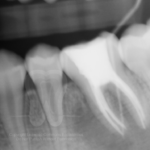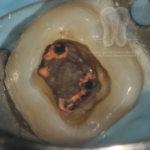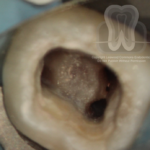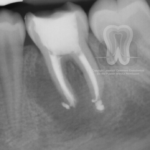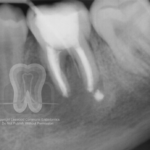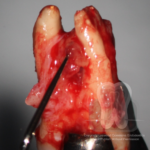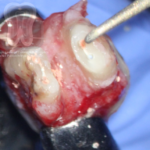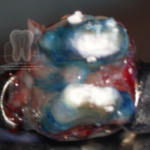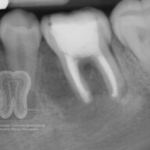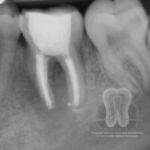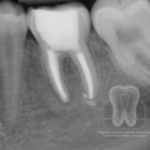Intentional replantation of #19.
This 14-year-old patient presented asymptomatically with a draining sinus tract buccal to the mesial root apex of #19. Retreatment was performed, and an additional canal was identified. Three weeks of calcium hydroxide as an intracanal medicament was used prior to obturation. One month after obturation, a draining sinus tract was again noted in the same location. No probing defects were detected. (See images 1-6)
Due to the persistent draining sinus tract and possibility of vertical root fracture, intentional replantation was performed. (See images 7-12)
Intentional replantation is seen as a last resort to save a tooth after other procedures have failed, and therefore is not a common procedure. However, its viability as a treatment option is strongly supported in the endodontic literature. The take home point is this: there is a lot that can be done to save teeth. The presence of a periapical lesion after initial root canal treatment, and even after non-surgical retreatment, is no reason to pursue extraction and replacement of the tooth. Endodontic microsurgeries such as apicoectomy, performed by endodontists using modern techniques, have high success rates (over 90%) as reported in the literature. Occasionally endodontists employ other surgical techniques, such as intentional replantation, to save teeth as well.
Useful links for additional intentional replantation information:
http://www.jendodon.com/article/S0099-2399(15)00931-0/abstract
http://www.theendoblog.com/2010/03/indications-for-intentional.html
We love this sort of thing and hope you found it interesting too. We’re sharing this case because we enjoy discussing all things endo. If you are an endodontist or dentist with thoughts on this case, we would love to hear from you and add your contributions to this post.
Want to use our photos in a presentation or publication? Please email us and we’ll send you high-resolution original photos.

